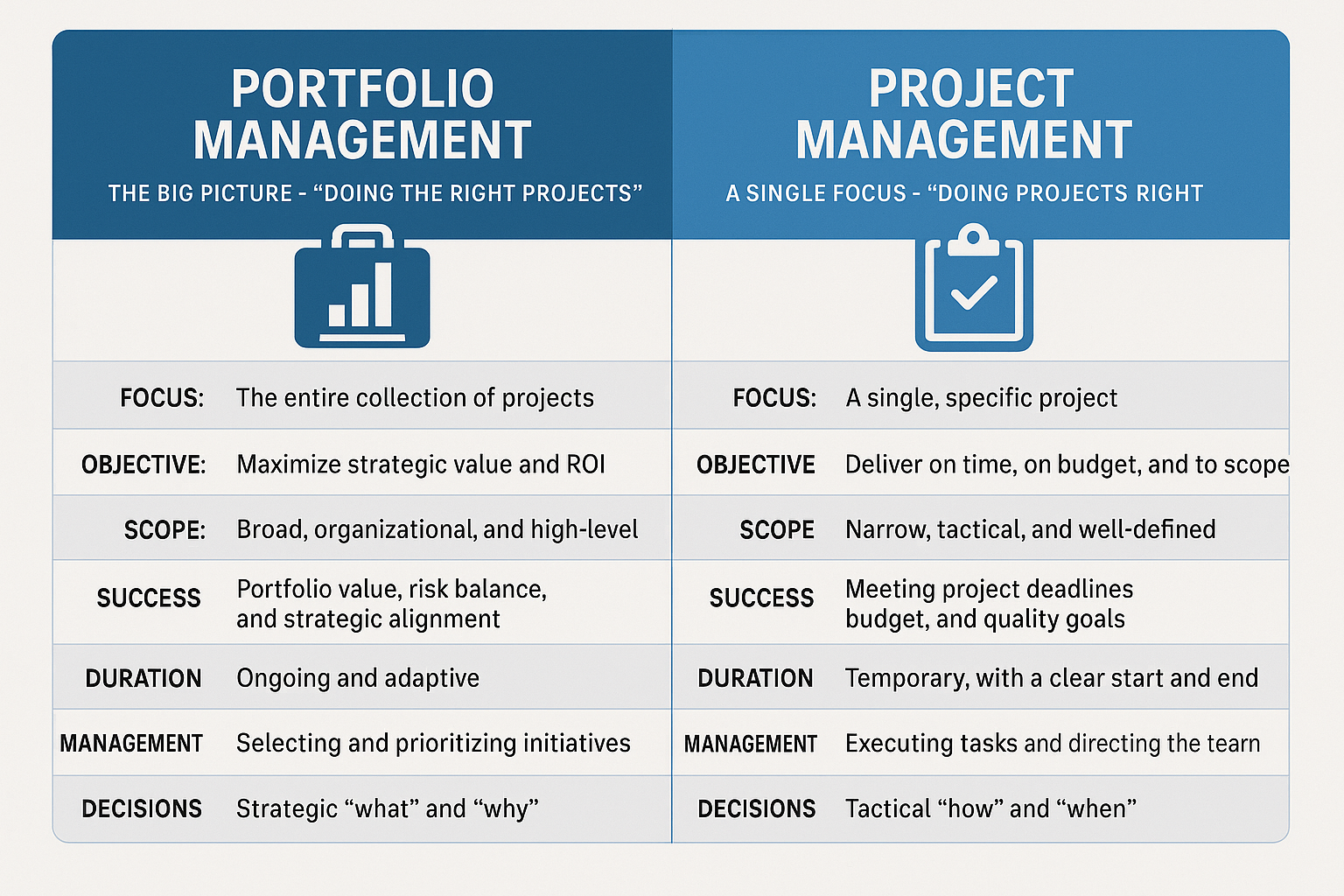Introduction
To drive real growth, your business must answer two critical questions: “Are we doing projects right?” and “Are we doing the right projects?” This is the fundamental difference between portfolio management and project management, and mastering both is the key to turning your strategic vision into tangible results.
These two terms may seem like common corporate jargon, but both aim to drive organizations toward better performance; they differ in purpose, responsibility, and score. Project management is all about executing a task efficiently. On the other hand, portfolio management involves selecting the right task to execute first. Misunderstanding these two terms can lead to wasted resources, misaligned objectives, and inefficient operations.
This detailed guide will help you understand the difference between portfolio and project management. Besides, you will know why achieving a perfect balance between them is crucial for businesses. Let’s get started with a brief introduction for both.
These two terms may seem like common corporate jargon, but both aim to drive organizations toward better performance; they differ in purpose, responsibility, and score. Project management is all about executing a task efficiently. On the other hand, portfolio management involves selecting the right task to execute first. Misunderstanding these two terms can lead to wasted resources, misaligned objectives, and inefficient operations.
This detailed guide will help you understand the difference between portfolio and project management. Besides, you will know why achieving a perfect balance between them is crucial for businesses. Let’s get started with a brief introduction for both.
Project Management & Portfolio Management- A Short Brief
Before diving deep into the guide, let’s establish a clear understanding of project management and portfolio management.
Example: Creating a website for your company, launching a new product, or developing an app.
Example: Managing necessary tech-related tasks to support the organization’s digital transformation objectives.
To get a clearer understanding of project management and portfolio management, let’s have a look at some major characteristics of each element.
Project Management:
It involves proper planning, execution, and completion of projects designed to attain certain goals within a specific timeline and budget. Project management focuses on offering outputs, whether it is a service, product, or improvement, through strategic phases. It generally focuses on goal-specific or short-term tasks instead of continuous operations.Example: Creating a website for your company, launching a new product, or developing an app.
Portfolio Management:
It is a process that involves centralized management of multiple programs and projects to attain strategic objectives. A portfolio is a combination of operational work, programs, and projects grouped to offer effective management. Different from a project, a portfolio is dynamic and ongoing.Example: Managing necessary tech-related tasks to support the organization’s digital transformation objectives.
To get a clearer understanding of project management and portfolio management, let’s have a look at some major characteristics of each element.
Key Characteristics of Project and Portfolio Management
Project Management’s Characteristics
- Temporary Timeline: Every task has a preset start and end date. The task needs to be completed within that time.
- Defined Scope: Every project has specific and clear boundaries and deliverables. The project manager must ensure the scope is under control.
- Tactical Focus: Project managers focus on the tactical and operational aspects of project execution. These aspects are schedules, budgets, resource allocation, task management, and development teams.
- Success Measurements: Factors like budget, project completion time, etc., are considered to measure success.
Characteristics of Portfolio Management
- Ongoing Timeline: The portfolio management keeps going with the organization, evolving with the changing requirements.
- Broad Scope: The scope is connected to the strategic objective of the business. It covers a collection of multiple initiatives.
- Focus: Here, the focus will be on the bigger picture. The project should help businesses get maximum value and align with the strategy. It should have a balanced risk profile.
- Value Maximization: The objective is not just to finish the project on time, but also to ensure that it offers maximum ROI.
- Factors to Measure Success: A portfolio’s contribution to a business’s market share, financial return, and risk-to-reward ratio are considered to measure success.
Portfolio Management VS Project Management

Check the table below to understand the distinction between portfolio management and project management.
| Parameters/Basic Difference | Portfolio Management | Project Management |
|---|---|---|
| Focus | Focuses on multiple projects within an organization | Focuses on a particular project |
| Objective | To increase the portfolio’s value and align it with the strategic goal of the business | To complete a project successfully within the timeline and budget |
| Scope | Provides high-level oversight of multiple initiatives across the organization | Focuses on multiple tasks within the project to attain the desired outcome. The scope is well-defined and narrow. |
| Success Measurement | Risk balance, portfolio ROI, strategic alignment, and value delivery | On-budget, timely completion, and within-scope project delivery |
| Duration | Ongoing process, adapting to change as the situation | A temporary process, with pre-decided start and end times |
| Scale | Generally used for large-scale and small-scale projects | A good option for small and more detailed projects |
| Management Level | It is about choosing and implementing the right tasks for businesses to achieve their long-term goals | It directs a single project or task successfully |
| Decision Making | High-level decisions regarding the project selections are based on the value | Execution-level decisions to complete projects |
Do Businesses Need to Focus on Both Portfolio and Project Management?
Undoubtedly, the answer would be “Yes”. Project and portfolio management are like two sides of the same coin. Only when they are combined strategically will you achieve success. Depending only on one element may result in a product that fails to bring strategic value and may also lead to stagnation.
Imagine a vehicle. Project management is the engine to that vehicle, providing it with the power to move forward. A robust engine can help you reach your destination faster. On the other hand, portfolio management is the GPS and steering wheel. It determines the direction and ensures the power from the engine is being directed in the right direction.
Businesses should not just focus on them; they need to come up with a strategy to integrate them. While portfolio management establishes direction, project management drives every initiative toward successful execution. Let’s explore the reasons for businesses to implement portfolio and project management.
Imagine a vehicle. Project management is the engine to that vehicle, providing it with the power to move forward. A robust engine can help you reach your destination faster. On the other hand, portfolio management is the GPS and steering wheel. It determines the direction and ensures the power from the engine is being directed in the right direction.
Businesses should not just focus on them; they need to come up with a strategy to integrate them. While portfolio management establishes direction, project management drives every initiative toward successful execution. Let’s explore the reasons for businesses to implement portfolio and project management.
Why Do Businesses Use Portfolio Management?
There are multiple reasons why an organization might opt for portfolio management. A primary reason behind this is to bridge the gap between creating a strategy and execution. Some other reasons are:
- It provides a solid framework to make sure every task and resource used contributes to the organization’s strategic goals.
- Portfolio management helps in the effective allocation of resources such as capital, workforce, equipment, etc., to ensure the highest ROI.
- It can help businesses with prioritizing and tracking multiple initiatives, providing a clear view into the progress and milestones of crucial projects.
Why Do Businesses Use Project Management?
While portfolio management revolves around “what to do,” project management makes sure that the task gets done. Some reasons why businesses focus on project management are:
- It brings a robust structure to project execution.
- Project management defines processes, timelines, and roles.
- It ensures that all allocated resources are utilized effectively to finish tasks on time, while reducing waste.
- Through proper resource management, project management helps save money and time.
- It can help enhance coordination and communication between teams, stakeholders, and departments. This helps to keep everyone aligned during the project lifecycle.
- Through a structured execution and control, it ensures that the final product meets the desired specifications and standards.
Difference Between Project Manager & Portfolio Manager
A clear understanding of the difference between a portfolio manager and a project manager is crucial for businesses aiming to streamline their strategic alignment as well as tactical execution. Both are important for business growth. But their objectives, decision-making responsibilities, and functions differ greatly. Here is a detailed comparison that can help you clarify their distinctions.
Project Managers:
A project manager is considered a hands-on leader and focuses on a single task or project. Project managers are like the captain of a ship. They are responsible for handling the project plan, project character, daily tasks, and structure. They are generally involved in the strategic execution, solving issues, leading the team, and navigating the challenges of the projects to attain the objectives.Portfolio Managers:
They are like strategic leaders who primarily focus on a group of projects. Their work environment is defined by the business’s strategic plan, market analysis, resource planning, and financial forecasts. They closely work with senior management to decide the correct initiatives, study business cases, and track the overall performance of the portfolio they are managing. A portfolio manager is responsible for ensuring that the team is heading in the right direction to complete a project on time. Have a look at the table below to know more.Portfolio Manager Vs Project Manager
| Characteristics | Portfolio Manager | Project Manager |
|---|---|---|
| Scope of Work | Optimize a portfolio for efficiency and performance. | Ensure that every project meets time, quality, and cost, and is delivered within the deadline |
| Stakeholder Interaction | PMs, department heads, and Executives | Clients, vendors, and project teams |
| Key Skills | Problem-solving, analytical skills, leadership skills, strategic thinking, and financial management skills | Conflict resolution, decision-making, communication, leadership, and risk analysis |
| Primary Goal | Ensure prioritization and strategic value | Complete and deliver projects |
| Success Metrics | The portfolio’s ability to offer higher ROI and support the desired business objectives | Meeting project goals, quality, budget, and schedule |
Key Responsibilities of Project and Portfolio Managers
Responsibilities of a Project Manager
- Planning and outlining budget requirements
- Scheduling and prioritizing projects or tasks
- Forming and leading a project team
- Establishing clear project goals and results
- Communicating crucial project information with stakeholders
- Tracking all tasks and projects and reporting on the current status
- Ensuring the quality of the final products
Responsibilities of A Portfolio Manager
- Prioritizing projects
- Identifying trends and patterns across different projects
- Optimizing financial and human resources
- Developing as well as maintaining the framework and processes of portfolio management
- Monitoring performance, value, and risk of the portfolio
- Panning out multiple “what-if” scenarios
- Reporting on portfolio health as well as business impact
Agile Project Management
Project Management Guide
S Curve in Project Management
Top Web Based Project Management Softwares
Final Words: Maintaining A Perfect Balance
Portfolio management and project management are not just two different elements. They are crucial forces in a successful business. Instead of deciding which one to choose, the focus should be on understanding how and when to leverage both.
Portfolio management comes with the required strategic wisdom to choose the correct method, and project management offers businesses the executional excellence. Whether you are a startup introducing your new product or a large-scale business focusing on digital transformation, an effective combination of project management and portfolio management will be a key to transforming your ideas into desired results.
Portfolio management comes with the required strategic wisdom to choose the correct method, and project management offers businesses the executional excellence. Whether you are a startup introducing your new product or a large-scale business focusing on digital transformation, an effective combination of project management and portfolio management will be a key to transforming your ideas into desired results.
FAQs
What’s the core difference between PM and PPM?
Think of it this way: PM (Project Management) is about doing projects right—focusing on the tactical execution to deliver on time and on budget. PPM (Project Portfolio Management) is about doing the right projects—focusing on the strategic selection of initiatives that bring the most value to your business.
Is a Portfolio Manager more senior than a Project Manager?
Yes, typically. A Portfolio Manager operates at a strategic level, deciding what projects to pursue to meet business goals and working with executive leadership. A Project Manager operates at a tactical level, managing the team and resources to successfully complete a single, assigned project.
How do projects, programs, and portfolios fit together?
It’s a strategic hierarchy. Projects are the individual tasks. Programs are a collection of related projects managed together. A Portfolio is the highest level, containing all projects and programs that are aligned with your company’s overall business objectives.
What is the difference between a PMO and PPM?
This is the “who” vs. the “what.” A PMO (Project Management Office) is the who—a central department that standardizes processes and governance. PPM (Project Portfolio Management) is the what—the strategic discipline of selecting and managing projects for maximum value. A PMO often oversees the PPM process.
Why can’t my business just focus on one?
Because they are two sides of the same coin: strategy and execution. As the article states, portfolio management is your GPS—it sets the direction. Project management is your engine—it provides the power to get there. Focusing on one without the other means you might efficiently complete the wrong project, or have great ideas with no way to implement them.



